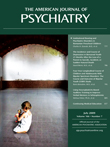The Use of Short Half-Life Antidepressants in the Treatment of Bipolar Depression
To the Editor: In the February 2009 issue of the Journal , Mark A. Frye, M.D., et al. (1) , and Joseph F. Goldberg, M.D., et al. (2) examined the predictors of treatment-emergent mania and mixed states in depressed bipolar patients. I would encourage both groups of investigators to review their data to examine two variables that have not been reported. The first is the diurnal variation of mood, which I find to be more extreme in patients who have bipolar depression and may be a predictor of a response to a mood stabilizer in unipolar patients. The second variable is the form of antidepressant given to patients. A convention in publishing is to use the generic names of medications, but this does not distinguish among the three preparations of bupropion (immediate release, 12-hour release, and 24-hour release) and two forms of venlafaxine (immediate- and time-release). Although time-release preparations technically have the same half-life of the underlying compound, their sustained presence keeps blood and brain levels more constant, resulting in differing side effects and efficacy profiles.
I have found that in bipolar patients with extreme diurnal variation of mood (characterized by severe a.m.-hour depression followed by significant brightening in the evening), the non-time-release preparations of medications, such as bupropion and venlafaxine, given in low doses in the a.m. hours only can be very helpful and less likely to cause manic switching. Conversely, the long-acting preparations of the same medications tend to cause a reversal of diurnal variation, with improvement in the a.m. hours and agitation in the p.m. hours. It might turn out that short half-life reuptake inhibitors have a place in treating bipolar depression. Other relatively short-acting agents, such as atomoxetine, may also fall into this category.
1. Frye MA, Helleman G, McElroy SL, Altshuler LL, Black DO, Keck PE Jr, Nolen WA, Kupka R, Leverich GS, Grunze H, Mintz J, Post RM, Suppes T: Correlates of treatment-emergent mania associated with antidepressant treatment in bipolar depression. Am J Psychiatry 2009; 166:164–172Google Scholar
2. Goldberg JF, Perlis RH, Bowden CL, Thase ME, Miklowitz DJ, Marangell LB, Calabrese JR, Nierenberg AA, Sachs GS: Manic symptoms during depressive episodes in 1,380 patients with bipolar disorder: findings from the STEP-BD. Am J Psychiatry 2009; 166:173–181Google Scholar



